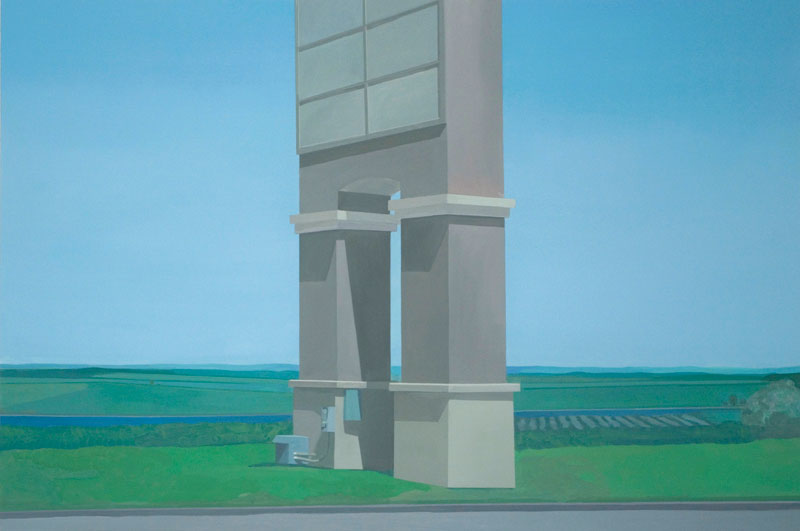
artpractical.com
October 2011

Naples Commons, 2011; oil on canvas. Courtesy the Artist and Gregory Lind Gallery, San Francisco.
Pastures
Jake Longstreth
Space feels awfully passé these days—a subject outmoded by the digital march of progress. As we collectively turn our attention from social networking to cloud computing to the next space-defying phenomenon, the notions of sheer distance and wide open pastures gather dust and threaten to resolve into romantic ideals. Jake Longstreth’s solo exhibition brings the danger inherent in this to the fore—the idealization of space is bound to discard the social realities of the places where space actually refuses to disappear.
These places are the subjects of Longstreth’s paintings. In particular, he depicts Midwestern exurbs: freshly minted communities plotted in the agricultural plains beyond the suburbs of cities such as Toledo or Cleveland. These places are where folks who have been squeezed out of the middle class but wish to maintain the semblance of their old lifestyle have the option to go. Between the seemingly endless expanse of farmland on one side and the long commute to the suburbs on the other stands a sparse smattering of big-box retailers, fast food joints, and parking lots. Here, space still reigns supreme.
Longstreth divides his canvases into horizontal strata. Typically he depicts a field, backyard, parking lot, or road in the foreground and rows of gradually less saturated color fields beyond to suggest the receding hills, producing an illusion of both openness and profound depth, such as one sees in Danbury (2010). Far more striking, however, is a pervading sense of absolute vacancy. There are no people, no cars in the lots, or any other hint of human life nearby.
Together with the paintings’ lack of detail—in Bob Evans (2011), for example, grass is a bladeless, smooth green color field—this absence weds space to a still, eerie silence that drives out what otherwise might have been placidity. The simply geometric, unpeopled paintings ultimately come to feel more like pared down memories or graphic renderings of proposed constructions than unmediated views. In this sense, they do hint at an ideal of bucolic or of suburban space, only to subvert it through the injection of an unmistakably exurban signifier: the backside of an electric, off-highway fast food directory in Naples Commons (2011), for example.
In thus igniting and then frustrating our desire for an idealized version of space as conveyed by a pasture, the exhibition reminds us that there is a reality corresponding to its representations. For the inhabitants who opted for longer commutes and a life at further remove from a cultural center, space is still a hard fact to ignore.